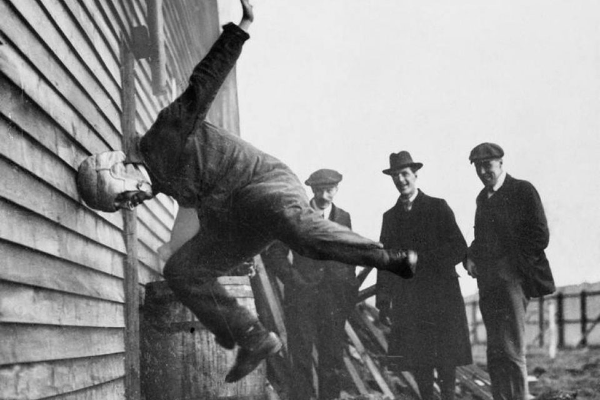Lorena Cupcake in a Giro Aeon
Have you ever gotten into an argument with someone who insists there is no benefit to wearing a helmet? Besides the obvious “I get too sweaty,” or “I don’t feel like carrying it around,” I’ve heard people claim, “I know how to stop in time,” or “I never crash,” or my favorite, “helmets don’t really protect you from a serious crash.” Interesting thoughts. I don’t particularly enjoy arguing, especially without all the facts, so I decided to look up some of the research. My initial intent was to write an article about how to win the annoying helmet debate with hard scientific data. When I got into it, I realized that there are a lot of articles, but also some obvious controversy.
Part of the problem is that this is a difficult topic to study prospectively. When you want to study the effect of a drug, you take 2 groups, give one the real drug, one the fake drug (placebo), and follow them over time, looking at your chosen outcomes (blood pressure, stroke, mood, whatever). With helmets, it’s not feasible to give one group of people a helmet, another group a cute hat, and then wait around for them to crash. For this reason, many of the studies take the people who have already crashed, and look backwards to see whether they were wearing a helmet, and then compare them to others who weren’t. One of the problems with this is in the selection of the subjects. For example, if you’re working in a hospital trying to recruit subjects from the emergency department, you’re not going to see the people who did great and walked off the scene of the accident, you’re only going to see the ones who needed to come to the hospital. So, what if the people who wore helmets mostly did OK and just went home, but the ones that turned up in the hospital (and consented to be in your study) were only the ones in the most serious accidents? That’s just an example of what these scientists are arguing about in these articles.
THE REVIEW ARTICLES
Dr. Dana in a Giro Saros
So, back in 2001, some scientists (Attewell, Glase and McFadden) did a meta-analysis, which means they combined a bunch of research studies together and looked at the data from all of them to find trends. This showed that bicycle helmets decreased the risk of head injuries, and they published that paper in a scientific journal. However, their study was criticized for being biased (specifically publication bias, meaning you’re less likely to get published if your study supports an unpopular idea, such as, “bike helmets don’t help”). Another researcher (Elvik) re-analyzed the data in 2012, correcting for that bias, and the corrected data still showed that helmets did provide protection from head injury (to a lesser extent), but less of a protective effect for facial and neck injury. This sounds reasonable; a typical bike helmet does not cover your face or stabilize your neck.
Tiny Giant Dana in a Bell
Another article, this one a Cochrane review, was written in 2009 by Thompson. Cochrane reviews also take many studies and look at the data, but they are known for being extremely picky about which studies are and are not included. In this particular review, 4 of the 7 studies included were done by the same people who authored the review, so make of that what you will. They found that based on the 7 studies they reviewed (4 of which were their own), helmets reduced the risk of head, brain and severe brain injury for all ages of bicyclists by 2/3 or more, as well as provided protection for the forehead and eye area, though not the lower face.
THE BIOMECHANICAL DATA
The other aspect of the helmet debate involves looking at the actual protection a helmet provides against an impact, which means we have to look at the biomechanical data. There was a recent article published in the Journal of Neurosurgery: Pediatrics in December 2012, which took skulls from cadavers (morbid, I know), filled them with BBs and cement until they were a certain weight, put bike helmets on some of them, and dropped them onto a steel anvil from increasing heights until they fractured, and measured the forces with an accelerometer (that thing they’re always using on Mythbusters, also the thing in your iPhone that senses when you turn it on its side and flips the screen). They also squashed the skulls with compressive forces to measure the how much force it took to break them. Surprise! Helmets worked, decreasing acceleration and increasing the force needed to crush either the skull or helmet alone. The big issue, of course, is that bike crashes don’t follow the rules of laboratory testing. You can make assertations based on what you’ve tested, but you can’t necessarily generalize those results to a wider population.
Eben Weiss, AKA BikeSnobNYC, in an awesomely teal helmet at On The Route Bikes
The fundamental issue being tested here is whether or not when bicycle riders crash and hit their heads, they are benefited by wearing a helmet, and the Cochrane review as well as other research, appears to confirm this. Here’s the thing about head injuries, though. You can’t really lump them all together. There are a couple of different mechanisms. If you slam something directly into your skull (or your skull directly into something, think, falling and hitting your head onto the ground), you could fracture the skull and damage the underlying brain tissue. A different mechanism is angular or rotational acceleration, meaning the forces don’t come straight at your head, but rather, you experience an impact, your head swings around, and your brain sloshes back and forth inside your skull like tofu in water, shearing nerve cells and tearing the connections apart, causing diffuse injury to the brain. These studies have all lumped brain injuries together, not distinguishing between focal injury such as a skull fracture and bleed, and diffuse injury such as concussion or diffuse axonal injury (DAI). A fundamental principle of research is that you can’t come to conclusions on outcomes that you didn’t test. We can’t really make any assertions about whether helmets protect against traumatic brain injury or not, because nobody’s done that specific study. It’s not that they don’t help, we just don’t know because much of the research hasn’t been able to ask the right questions yet.
(not how helmets are tested)
HELMET LAWS
meow
A large part of the controversy lies in what’s done with this data, particularly with regard to helmet laws. It seems odd that that while studies have reported large protective effects of bicycle helmets, mandatory helmet laws haven’t always shown a decline in head injuries in cyclists. One thought about why this is the case is called selective recruitment, which means that cyclists who are more cautious and safety-conscious, are the first to start wearing helmets, and these cyclists have lower injury rates anyway. Since you’re looking at the entire population, only the people with fewer accidents are protected, there is less of an effect on the larger population, even if the protective effect of the helmet on an individual cyclist is great. Another idea, known as “risk compensation,” is the idea that cyclists who wear helmets feel better protected and adopt more risky riding behavior. This has been shown in some other areas, such as driving and football, but nobody has proved this with regard to cycling, and it would be a very difficult issue to study.
Another big question is whether enforcing a mandatory helmet law will deter people from riding bikes, meaning fewer bikes on the road, and fewer people getting the exercise benefits of cycling. I read a study by deJong that attempted to answer this question using mathematical modeling. The “benefit” is reducing head injuries. The “risk” is decreasing people’s desire to ride bikes (therefore increasing rates of chronic illness secondary to low fitness). I only pretend to really understand what they were trying to do with the math, since much of the article looked like this:
ouch
The effect of bicycle helmets on societal health is intimately tied to the environment and infrastructure where one is cycling. In Copenhagen and Amsterdam, where cycling infrastructure is great, cyclists do not have to share the road with fast car traffic. In Chicago, this isn’t the case; so how important is it for Chicagoans to wear helmets when they bike? DeJong’s conclusion was that in places where cycling is safe (Copenhagen), a helmet law will probably deter people from cycling, leading to a negative public health impact. In places where cycling is relatively unsafe (i.e. Chicago), helmets will do little to make it safer and a helmet law, under relatively extreme assumptions, may make a small positive contribution to net societal health. SOCIETAL HEALTH.
Let me make this clear. The article is not talking about INDIVIDUAL HEALTH. So if you save a few people from injury, but crashes are relatively uncommon given the ENTIRE POPULATION of a particular place, there’s no way you’ll see large, dramatic numbers.
Dr. Dana in a Bern
The recent crash involving Dustin Valenta is an example of the vulnerability of cyclists, even an experienced cyclist riding on a bike route, with traffic, during broad daylight, wearing a helmet. Even when we do everything to protect ourselves, in this place, at this time, there are risks. Ultimately, making cycling a safer mode of transportation and recreation will take a serious change in both the infrastructure of the city and the attitude of the motorists towards cyclists. Lucky for us, we have highly intelligent and motivated people advocating for this. In the meantime, wearing a helmet is a reasonable thing we can do to protect ourselves given the current situation.
THE BIG QUESTION
Working on a traumatic brain injury unit, I have seen the physical, cognitive and neurologic changes that occur in brain injury. After a patient has a portion of their skull removed to allow for brain swelling, they need to wear a helmet just to get out of bed. But it’s not my goal to scare you. If you’re looking for hard and fast science that shows that a skull with a helmet on isn’t going to fracture as easily as one without, we have that. If you need to be convinced that everything in the world gets better when you wear a helmet, I can’t do that. I’ve presented the data as fairly as I could, and now it’s your decision to make.
So then the question becomes, how much proof do you need? How much are you willing to be inconvenienced by having to carry a helmet around? Looking around at where you live, right now, how much of a chance do you want to take?
One thing, however, is certain. Helmets are sexy (see above).
References:
Attewell, R.G., Glase, K., McFadden, M., 2001. Bicycle helmet efficacy: a metaanalysis. Accident Analysis and Prevention 33, 345–352.
Curnow WJ. The efficacy of bicycle helmets against brain injury. Accident Analysis and Prevention. 2003 Mar;35(2):287-92.
de Jong P. The health impact of mandatory bicycle helmet laws. Risk Anal. 2012 May;32(5):782-90.
Elvik R. Publication bias and time-trend bias in meta-analysis of bicycle helmet efficacy: a re-analysis of Attewell, Glase and McFadden, 2001. Accident Analysis and Prevention. 2011 May;43(3):1245-51. doi: 10.1016/j.aap.2011.01.007. Epub 2011 Feb 12.
Mattei TA, Bond BJ, Goulart CR, Sloffer CA, Morris MJ, Lin JJ. Performance analysis of the protective effects of bicycle helmets during impact and crush tests in pediatric skull models. Journal of Neurosurgery: Pediatrics. 2012 Dec;10(6):490-7.
Thompson, D.C., Rivara, F., Thompson, R., 2009. Helmets for preventing head and facial injuries in bicyclists. Cochrane Review. The Cochrane Library 1. (PDF available for free)








